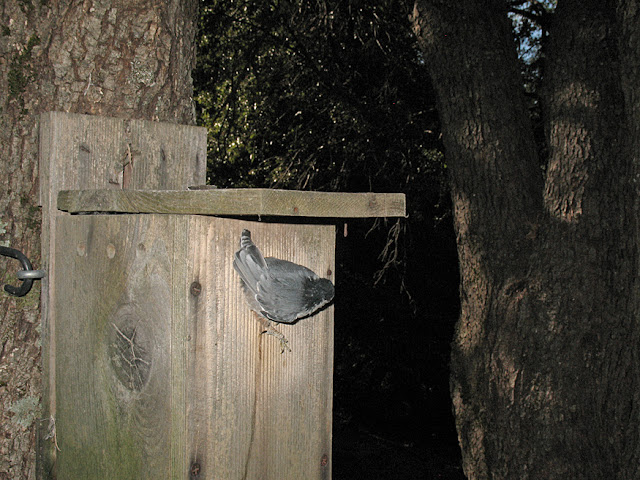I hope the incubating nuthatch in this box was satisfied with its mates' choices of carry-out.
During incubation he served his lady a lot of legless carpenter ants, and she accepted them eagerly.
Occasionally he served her a red ant, but . . .
the mainstay was caterpillars (which Mr Smiley identified as those of noctuid moths). He also delivered shelled sunflower seeds from our bird feeder.
He was a bit of a show-off. His acrobatics were eyecatching, . . .
but he didn't hang around after deliveries.
I was puzzled by the occasional delivery of squirrel fur, a feather, and perhaps paper mache from wasps' nests.
At these times he was also photographed peering into a gap in the box.
The old nest box was coming loose at the backboard, and I gather the materials were intended for nest maintenance -- an attempt to chink the gap with fuzzy bird oakum.
Finally the hen appeared with a fecal sac, and I knew the eggs had hatched.
Apparently she made hasty exits, because the camera trap never caught this action again.
When the chicks hatched, spiders and small beetles were added to the mainstay of caterpillars . . .
and then moths replaced caterpillars.
The camera snapped one youngster the day before the family suddenly disappeared.
Except for yellow rubber-band lips and short tail, junior looked just like its parents.
The little imp also looked vulnerable, especially clinging to the box.
The next morning . . . (insert a heart-rending "oh no" here) . . . my camera caught several images of a Steller jay on top of the nest box.
I immediately checked it out with a flashlight.
The box was empty. There were no nuthatches at the feeder either.
I started to think the worse. Did the jay eat the fledglings? (Of course it did, you damn fool. Wasn't it just there, looking for more?)
It would have been so easy to nail the little buggers, and that's probably what happened. (Hey, you're a biologist. This is how it works.)
Two weeks later four nuthatches showed up at the feeder.
If the jay dined on tender nuthatch, it didn't get all of them.















6 comments:
Excellent sequence & beautiful photos. That was a great set up.
What a great story, love the photos and the melodrama. I wonder how often Steller's Jay fledlings get eaten by bigger predators?
I had nuthatches use a nest box once — and then never again. Maybe they don't like the cracks in it. I should fix those. Meanwhile, I have to be contented with the usual Cordilleran flycatchers on the front porch, which should hatch any day now.
Love all your tales & photos.
Hey Codger
Great photos and story! We are watching our Chesnut-backed Chickadees closely and
so are the Stellar's Jays!
Terry
If the young have a tough time at the box entrance, it occurs to me that perhaps nest boxes should have external structures that the young can explore around on more safely to strengthen their legs and feet until they become as acrobatic as their parents. They can do this in a natural nest tree, where also bark might be easier for young claws to grasp than smooth wood planks. Your photos and narrative are suggestive.
Post a Comment